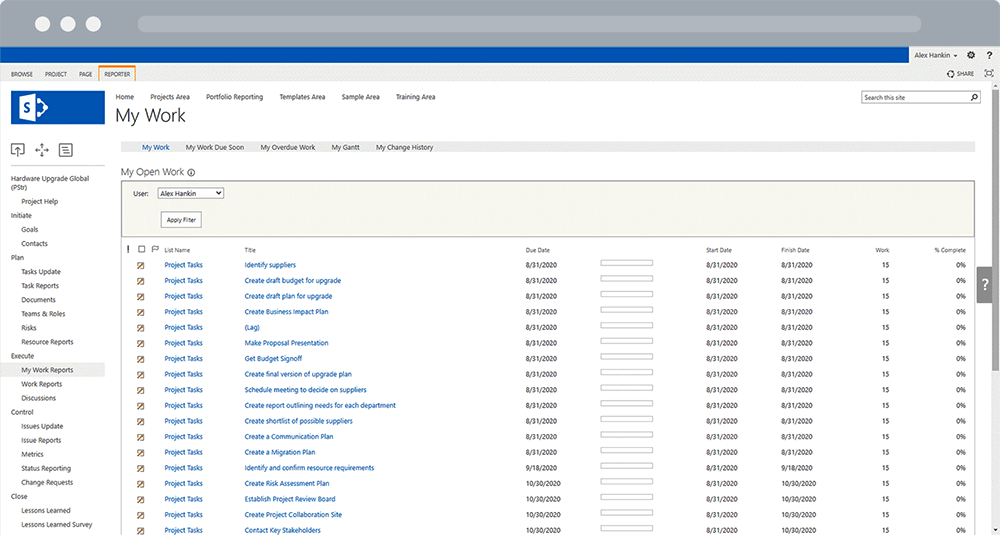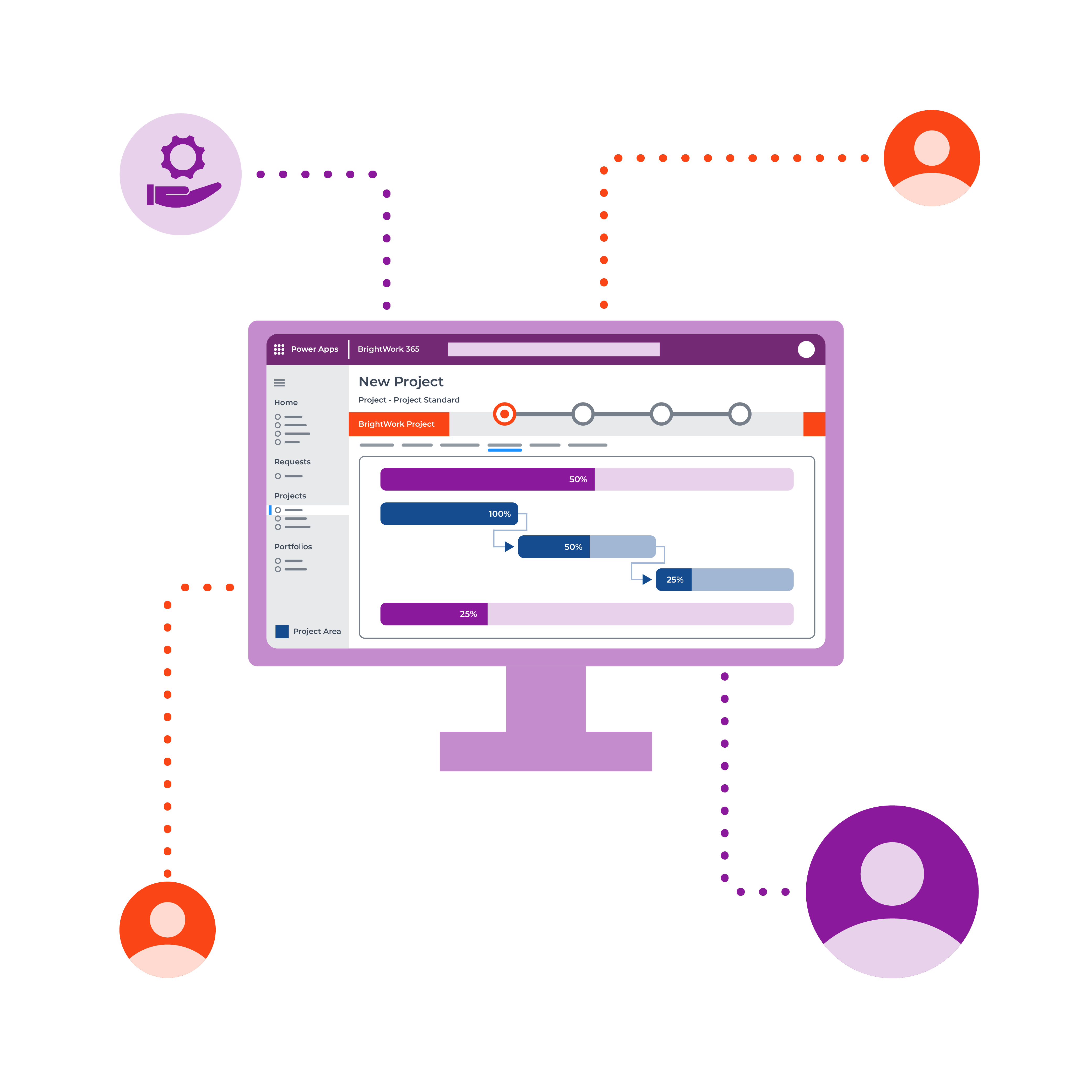The steps and screenshots of the template in this article apply to SharePoint 2013, SharePoint 2016, SharePoint 2019 and SharePoint Online, as well as SharePoint 2013. The template used in this guide requires SharePoint classic mode.
With its team sites, robust document management capabilities, and out-of-the-box integration with Microsoft Project, SharePoint On-Premises is an ideal project and portfolio management platform.
Download your free, no-code, SharePoint project template [Access now]
A SharePoint project site centralizes all project information in one place, improving visibility, reporting, and collaboration.
With a few simple configurations to your SharePoint environment, you can update your site to match the project at hand.
In this article, you’ll see how to use the SharePoint Quick Launch, task lists, reports, and sync with Microsoft Project.
How can you customize SharePoint to suit your project management needs?
Launched in 2001 as a web-based collaborative platform, Microsoft SharePoint is a collection of tools designed to help organizations build intranets, manage documents, and collaborate in a secure environment.
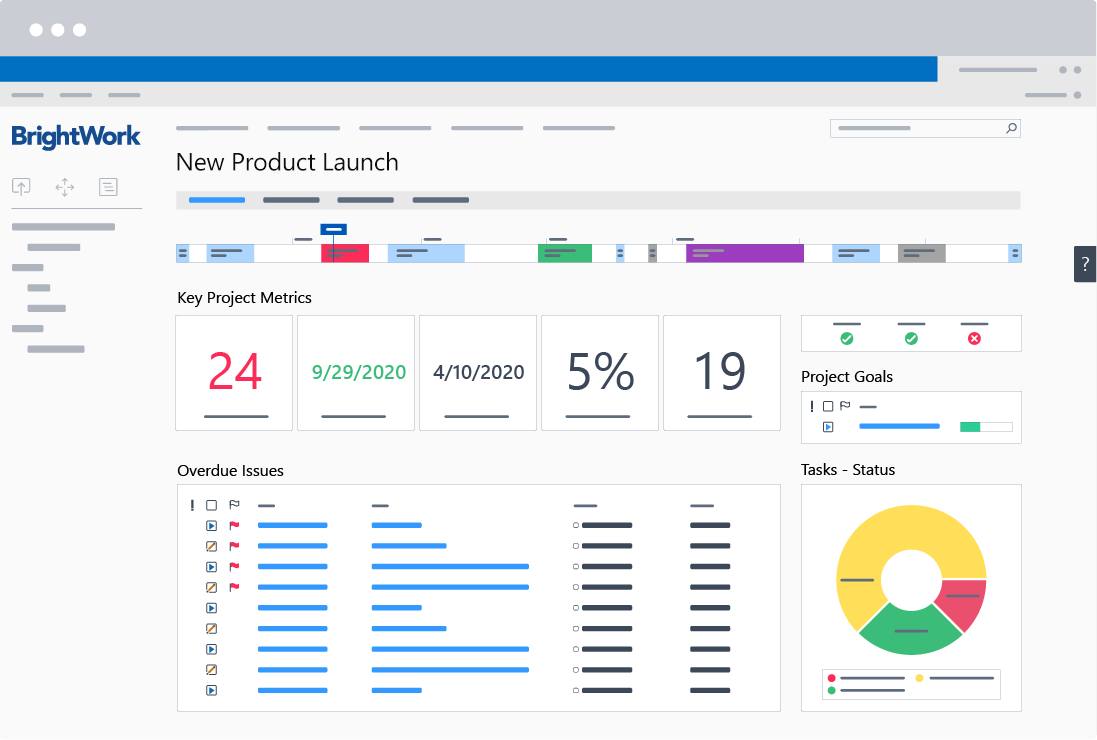
SharePoint features and functionality include:
- Document management and sharing
- Intranet portals
- A newsfeed
- Wikis and forums
- Knowledge management
- Security settings such as encryption and permissions.
The structure of a SharePoint site, especially lists and web parts, makes it easy to organize and manage a project.
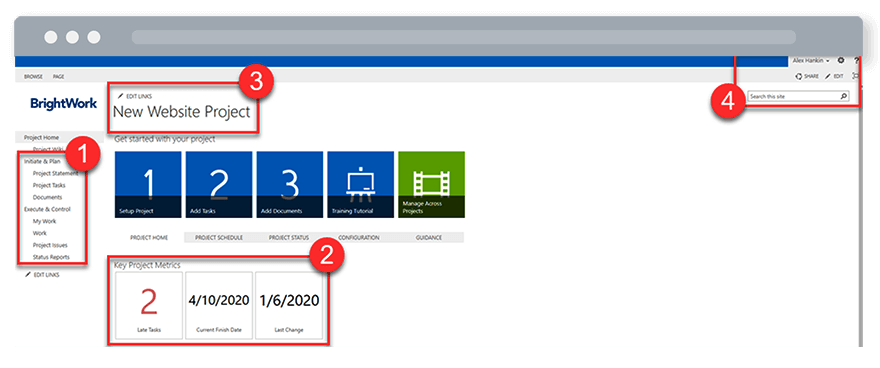
1. SharePoint Lists
A SharePoint site is populated by lists, which are used to organize information. Use lists to manage project information such as tasks, documents, risks, and goals.
2. SharePoint Web Parts
A SharePoint web part is a type of list used to store content in your site.
Web parts can function as a project dashboard or report, surfacing key project information in a usable way.
3. SharePoint Site
A SharePoint site is used to organize different types of content in one place. A SharePoint site is a home for your project, bringing together lists and web parts in one central location for your team.
4. SharePoint Site Collection
A SharePoint site collection is a collection of SharePoint sites. When applied to project management, a site collection acts as your project portfolio, rolling up information from various projects in one place.
A SharePoint project is a great way to centralize all project information, like documents, tasks, and reports, in one place for your team and stakeholders. This approach solves common challenges faced by teams such as poor visibility or hard-to-find information.
In a standard SharePoint site, you’ll need to configure lists and web parts to support project management. For the rest of this article, we’ll take a closer look at four key ways to configure your SharePoint site for project management.
4 Quick Steps To Set Up SharePoint For Project Management
1. Use the Quick Launch to manage project processes
In SharePoint, you can create team sites, which are essentially web pages for teams to collaborate and move work forward.
With some simple edits to the Quick Launch – navigation located on the left-hand side of the site – you can map your project management processes to the site. This makes it easier for your team to follow the right process.
When building your site, add lists and apps to manage all aspects of your project, including:
- The project statement
- Project issues
- Risks
- Tasks
- Goals
- Change requests
- Project status reports.
Add as much or as little process as you want – it’s up to you to decide what your team is ready for.
Group these links on the Quick Launch so that they map to various project phases. In the screenshots below, you’ll see an example of how this can be done in SharePoint.
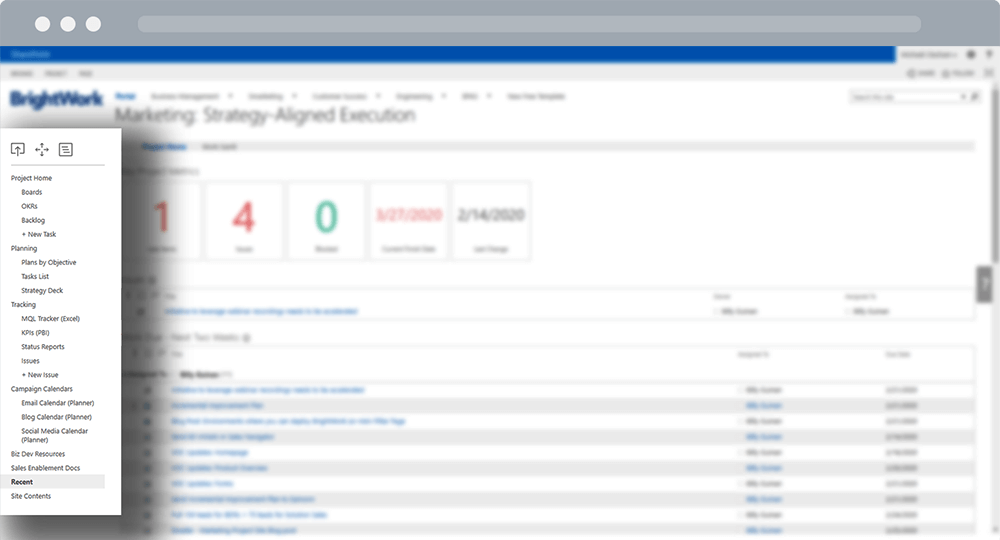
At BrightWork, we often use the below project management maturity spectrum with our customers. As you can see, different types of projects require varying levels of process.
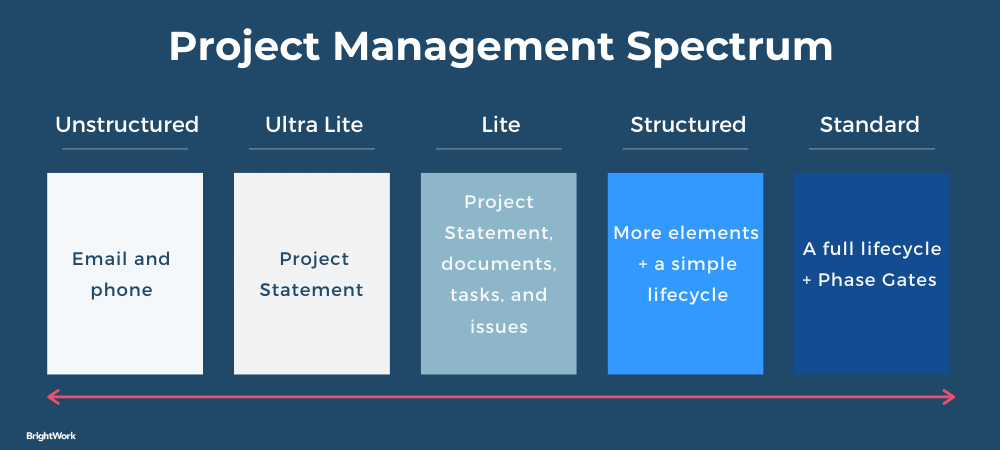
Following this model, it’s easy to configure the Quick Launch to support different project processes.
The most important part of updating the Quick Launch is that it matches your project management approach. It becomes the set of rail tracks to guide the team through the project and provides a window into the various project reports to keep the project going forward.
2. Manage tasks with work management lists and dashboards
All SharePoint team sites come with a Project Tasks list, which you can use to create the project schedule and manage the project plan.
Once the project is planned and responsibilities are assigned, create a series of work reports to track the tasks and work associated with the project.
With tasks in place, you can create add custom views to the list for easy tracking. These views can include:
- All Tasks: a view of the Tasks List with no filter, showing the full project plan.
- My Tasks: a view of the Tasks List with parameters “assigned to equals me” (the logged-in user) – giving each team member a place to manage their individual tasks. As team members work on the project and update their tasks, the project manager has a quick view of the progress of the project.
- Late tasks: a view of the Tasks List with parameter “status does not equal to completed” – providing the project manager and stakeholders an indication of the work that is still outstanding.
- Overdue tasks: a report with the parameters of “status does not equal to completed” and “due date is less than today” – a very handy report for getting a snapshot of tasks that have missed their deadline, so you can make adjustments and keep the project schedule moving.
Task status can also be tracked using Work reports and Issue Reports.
3. Create Project Status Reports
It’s really easy to create project status reports and dashboards using a list and workflow in SharePoint.
You can enter project information in a datasheet view and the workflow will turn that information into a project status dashboard.
When you “stop editing the list”, the datasheet will be transformed into a project status report with R-A-G status as well as other data such as health, time, cost, comments, percent complete.
You keep a history of these reports to reflect the status of the project at a point in time.
4. Use the Microsoft Project to SharePoint sync
The Tasks List in your SharePoint project site syncs seamlessly with Microsoft Project (Professional Desktop), significantly extending the project management capabilities of both SharePoint and Project.
With this capability, you can manage the project schedule in Microsoft Project and then sync that schedule back to the project site in SharePoint, where the team can access the plan and manage their work using the various work reports and task management views we discussed above.
And it really could not be easier!
In the video below, you can see that the SharePoint to Microsoft Project synchronization is as simple as the click of a button.
Once you have synchronized the Project Plan to SharePoint, the next time a team member enters the site, all of their work reports and dashboards will be updated with the latest deadlines and progress.
Likewise, they don’t even have to leave SharePoint to update the status of their work. Simply ticking off a task as complete will mark it done, and that task will also be updated the next time you open the plan in Microsoft Project.
Get Started with a SharePoint Project Management Template
All of this functionality is available with native SharePoint.
With a little bit of SharePoint know-how, you can do all of the above and get on the road to project management success with SharePoint. And one of my favorite features of SharePoint is the ability to save sites as templates.
Once your project site is set up the way you want, save it as a template to use over and over again, saving time and effort.
Configuring out-of-the-box SharePoint for project management requires both SharePoint and project management knowledge. If your site is not right for the project, you could run into some problems along the way.
That’s where the Free SharePoint Project Management Template from BrightWork will give you a head start. Not only does the template deliver all of the above and more – it was built for project managers by project managers!
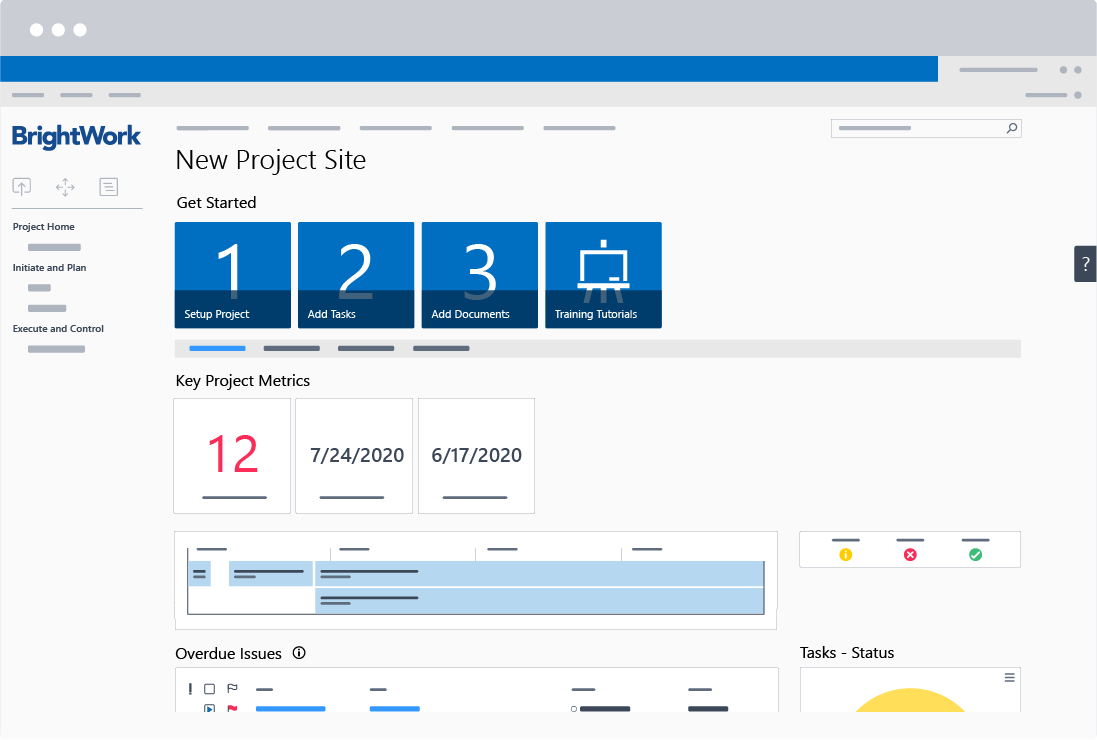
The site already includes the project management essentials to help you plan, track, and re-plan the project, including:
- Getting started Tiles
- Project Homepage with ‘at-a-glance’ information
- Quick Launch
- Wiki (Collaborative Project Management Process)
- Tasks list (mapped to the Wiki)
- Project Reports and Metric Tiles
- Document repository.
Leveraging SharePoint Online on Microsoft 365
Microsoft 365 allows users to leverage cloud technology by bringing together familiar tools in one subscription. Part of the Microsoft 365 platform, SharePoint Online is a cloud-based collaborative platform that organizations use to share and manage information.
SharePoint online is the perfect tool for project document management, providing a secure place to store files for your team to work together and access at any time from any device.
BrightWork 365 leverages SharePoint Online along with Microsoft Teams, Power Automate, Power BI, and Power Apps to create a complete Project Portfolio Management solution in Microsoft 365.
Editor’s Note: This post was originally published in November 2021 and has been updated for freshness, accuracy, and comprehensiveness.
Manage Projects and Portfolios with Microsoft 365
See how you can manage projects with Microsoft 365, Power Platform, Teams, SharePoint Online, and OneNote.

